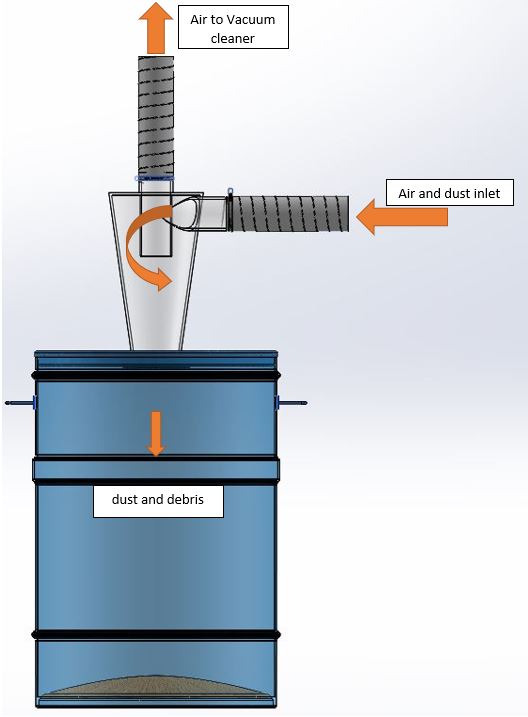Dust Extractor Vs Shop Vac Can Be Fun For Everyone
Wiki Article
Dust Extractor Vs Shop Vac Fundamentals Explained
Table of ContentsDust Extractor Vs Shop Vac for DummiesThe Facts About Dust Extractor Vs Shop Vac UncoveredDust Extractor Vs Shop Vac - The FactsDust Extractor Vs Shop Vac for BeginnersThe Main Principles Of Dust Extractor Vs Shop Vac Dust Extractor Vs Shop Vac for Dummies
The challenges for factory dirt collection systems focus on crystalline silica dirt, carbon monoxide, and also heat, which are hazardous mixes. These aspects make meeting air high quality criteria challenging as well as requiring. When picking a dust control system for a factory, the initial consideration is the capacity of the unit to endure extreme and hazardous work environment problems.Apart from the obvious conditions, the selected equipment has to satisfy the guidelines of OSHA, the EPA, and also the NFPA. To fulfill those criteria, dust collection systems utilize shakeout units, collection hoods, thaw, mold and mildew putting, cooling down hoods, as well as exhaust stacks. Pleated bag and cartridge-style collection agencies have an extremely effective filtering system in addition to a small dimension as well as lowered pressure drop.
Dirt collection systems for this type of operation should be particularly developed to fit the type of coating being used. The objective of the system is to manage and also decrease overspray as well as dust.
7 Easy Facts About Dust Extractor Vs Shop Vac Shown
It would appear likely to boost air movement and activity, this type of option may be ineffective as well as waste power. The design of the booth relies on the force of the air going into the cell or cubicle. For a lot of systems, it is essential to have a slight vacuum in the cubicle to stay clear of possible positive stress.Another approach is simply placing the makeup air link on the top of the cubicle. Despite the layout, it is essential for the cleaning of the air to have cross ventilation. Much like a cleanroom, air flow in a thermal spray cubicle can be either straight or downward, though the downward style is best for dirt collection systems. dust extractor vs shop vac.
The pharmaceutical sector is a highly controlled market with considerable and accurate laws. Dirt from drugs is generated mostly during the production and also product packaging of items - dust extractor vs shop vac. Each action of producing a medication, which consists of granulating, drying out, blending, pushing, covering, as well as grinding, creates big quantities of dirt that require to be gotten rid of.
The Definitive Guide for Dust Extractor Vs Shop Vac

HEPA filters are commonly found in pharmaceutical dust control systems since they are one of the most reliable and also trusted. Similar to a shop system, they are mounted as a second defense to accomplish zero emissions. click over here Reusing creates a lot of dust as an all-natural result of decreasing items to their basic materials.
Dirt stems after products are shredded, crushed, or have paint or lacquer got rid of. All reusing centers are needed to stick to air quality criteria. As they function to satisfy quality criteria as well as control contaminants, they have actually acknowledged that dirt control is a significant issue, bring about the large usage of dirt collection systems to mitigate and also consist of the problem.
The Greatest Guide To Dust Extractor Vs Shop Vac
When producers select a dust control system, they are encouraged by manufacturers about the type of system that would certainly best fit their requirements since acquiring and installing a dirt control system is a major investment. Particle issue is available in a wide range of types, from silicon dirt to wood chips as well as sawdust.Below is a short listing of the kinds of particles that dust collection systems can remove. Gypsum Plaster calls for a high-efficiency baghouse system qualified of running at temperatures near 428 F (220 C). Felt Felt is made use of in apparel manufacturing and also calls for dust collection systems at 3 phases of the procedure.
Metal Chips Grinding procedures produce metal click to read chips that need to be removed for the safety of workers. Baghouses and scrubbers are made use of for air movement purification. Sawdust This is one of the most usual product removed by dust collection systems. Cartridge or baghouse methods can be utilized, with baghouse being the most efficient.
Unknown Facts About Dust Extractor Vs Shop Vac
Fabric filter bags in a cartridge system are one of the most effective approach for gathering dirt. Cement Concrete dust is created throughout the movement and also transport of the item. Dust collection systems are covered to consist of the dust and tidy the air. Clay Clay dust is created in the manufacturing of bricks.
With the intro of dust collection systems, workers are more secure as well as more secured. Sugar Sugar dust is the spin-off of the production of candy.
Some Ideas on Dust Extractor Vs Shop Vac You Should Know
Rice Dirt Rice dirt has extremely fine as well as minute bits read the article that build up during the production of rice-based products. dust extractor vs shop vac. A dust collection system is required for the protection and safety of workers.Report this wiki page